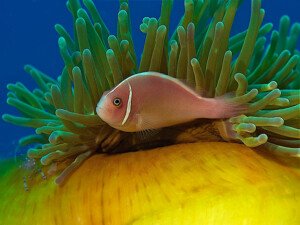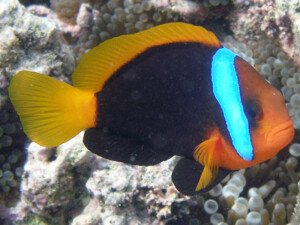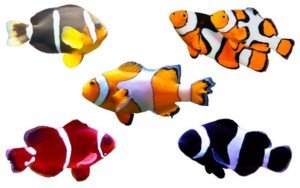Understanding Anemonefishes: An Overview
Anemonefishes, commonly known as clownfish, belong to the family Pomacentridae and are primarily found in the warm, shallow waters of the Pacific and Indian Oceans. These vibrant species typically inhabit coral reefs, where they reside in close association with sea anemones. The relationship between anemonefishes and sea anemones is a particularly fascinating example of mutualism in the marine ecosystem. While sea anemones provide a protective habitat for anemonefishes, the fishes, in turn, offer food and cleaning services to their host anemones.
anemonefishes and sea anemones is a particularly fascinating example of mutualism in the marine ecosystem. While sea anemones provide a protective habitat for anemonefishes, the fishes, in turn, offer food and cleaning services to their host anemones.
Physically, anemonefishes are strikingly colorful, showcasing a variety of hues such as bright orange, yellow, and even black, often marked with distinctive white bands. Their oval bodies and short fins contribute to their agility in navigating the nooks and crannies of coral reefs. Anemonefishes are also notable for their size, typically reaching lengths of 4 to 5 inches. Their unique reproductive behavior, where a dominant male and female pair share and defend an anemone, also highlights their social structure and adaptability.
The ecological role of anemonefishes is vital within their habitat. By living amongst sea anemones, they help to maintain the health of these sessile organisms. Additionally, anemonefishes contribute to the overall biodiversity of coral reefs, which are some of the most productive ecosystems on the planet. Their adapted morphology allows them to thrive in such environments, as they have developed a thick layer of mucus on their skin that protects them from the venomous stinging cells of sea anemones.
In summary, anemonefishes are not only remarkable for their physical attributes and behaviors but also for their critical ecological interactions within coral reef habitats. Their fascinating lifestyle reflects the intricate relationships that characterize marine biodiversity.
The Unique Characteristics of Anemonefishes
Anemonefishes, commonly known as clownfish, stand out due to their striking coloration and distinctive patterns. The vibrant hues, ranging from bright oranges and yellows to vivid reds, serve not only as a visual attraction but also play a role in their survival strategy. These colorful fishes possess a remarkable ability to blend into their home environments among sea anemones, providing effective camouflage against predators. The mutualistic relationship they share with these anemones is integral to their survival, as it offers them protection from external threats.
Size variations in anemonefishes can be observed across different species. Typically, they range from about 4 to 5 inches in length, although some species can grow slightly larger. This size consistency contributes to their dominance within their respective territories. Territorial behavior is a notable trait of anemonefishes; they are known to defend their anemones fiercely against intruders, ensuring that they maintain control over their breeding grounds and feeding areas. Such territoriality not only helps in safeguarding their young but also promotes their chances of successful reproduction.
A fascinating aspect of anemonefish behavior is their adaptability to the stinging tentacles of sea anemones. The jelly-like texture of these tentacles can be deadly to many marine species; however, clownfish have developed a unique mucous coating that protects them from stings. This evolutionary adaptation allows them to thrive in symbiosis with their host anemones, creating a safe haven for themselves while simultaneously offering the anemone food scraps and protection from predatory fish. The nesting behaviors of anemonefishes, where they lay eggs in close proximity to the anemone, further illustrate their acute strategies for survival and reproductive success in a competitive marine environment.
Species Diversity: How Many Types of Anemonefishes Are There?
Anemonefishes, also commonly known as clownfish, comprise a unique group of marine species belonging to the family Pomacentridae. As of now, there are approximately 30 recognized species of anemonefishes, varying significantly in coloration, morphology, and habitat preferences. These fishes are notably distinguished by their symbiotic relationship with sea anemones, which provide them both protection and a shared habitat.
Among the most well-known species are the false clown anemonefish (Amphiprion ocellaris) and the true clown anemonefish (Amphiprion percula). The distributions of these species are wide-ranging, predominantly found in the warm waters of the Indian and Pacific Oceans. Climate influences, ocean currents, and the availability of suitable anemones play crucial roles in determining their habitats. Each species shows some degree of adaptation to its specific environment, which contributes to the overall biodiversity within the anemonefish group.
and the availability of suitable anemones play crucial roles in determining their habitats. Each species shows some degree of adaptation to its specific environment, which contributes to the overall biodiversity within the anemonefish group.
Recent studies have revealed new insights into the genetic diversity and phylogenetic relationships among these species. Advances in marine biology have led to improved techniques for classifying anemonefishes, with periodic discoveries that challenge previous understanding of their evolutionary lineage. For example, the diversity of color patterns among different populations can often indicate previously unidentified species or subspecies. Additionally, as environmental changes continue to threaten marine ecosystems, ongoing conservation efforts are being established to protect these iconic fishes and their habitats.
In light of these developments, researchers focus not only on the cataloging of existing species but also on assessing their conservation status, particularly in the face of habitat degradation, climate change, and overfishing. Understanding species diversity among anemonefishes remains essential, as it not only sheds light on marine ecology but also highlights the vital role these fishes play in their ecosystems.
Interesting Facts About Anemonefishes
Anemonefishes, also known as clownfish, exhibit a multitude of fascinating traits that highlight their uniqueness within the marine ecosystem. Firstly, these colorful fish are known for their remarkable symbiotic relationship with sea anemones. Anemonefishes are immune to the stings of the anemone’s tentacles, allowing them to seek refuge from predators while providing the anemones with nutrients in return.
Secondly, anemonefishes display intriguing social structures. They are organized into strict hierarchies within their groups, typically with a dominant female, a male, and several subordinate males. The dominant female is responsible for breeding, and should she perish, the dominant male transforms into a female to take her place, demonstrating a fascinating aspect of sexual plasticity.
In addition to their social dynamics, mating rituals among anemonefishes are captivating. These rituals often involve elaborate dances and displays of affection, which serve to strengthen pair bonds and ensure successful reproduction. This intricate courtship behavior showcases their emotional intelligence and highlights the complexities of their relationships.
Moreover, anemonefishes are renowned for their resilience to harsh environmental conditions, including rising sea temperatures and increased ocean acidity. This adaptability is vital for their survival, particularly as marine ecosystems undergo significant changes due to climate change. Studies by marine biologists have shown that even under stress, anemonefishes can maintain stable populations, a testament to their robust nature.
Lastly, the survival strategies of anemonefishes are profound. They utilize their vibrant color patterns to communicate and deter potential threats. Not only are these colors captivating for human observers and photographers, but they also play a critical role in their survival within complex coral reef systems. The continued preservation of their habitats is essential for the ongoing success of these remarkable species.
